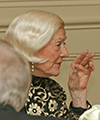Harvey Mudd Launches Hixon Center for Sustainable Environmental Design
October 1, 2015
Raising awareness about humanity’s increasing footprint on critical ecosystem services and resources is just one goal of the Harvey Mudd College Hixon Center for Sustainable Environmental Design, which the campus community officially launched Sept. 25.
“Hixon Center programs build on the many sustainability initiatives and goals achieved since Harvey Mudd’s founding and draw on the collaborative spirit of its faculty, staff and students,” said Tanja Srebotnjak, the inaugural Hixon Professor of Sustainable Environmental Design. She was hired in fall 2014 to found the Hixon Center, which is charged with expanding student and faculty experiences and promoting environmental science and design at the College and within the Claremont Consortium. The center works with its community partners to invigorate innovative thinking, scalable local action and global engagement, and to instill a high level of ethical and professional awareness in Harvey Mudd’s graduates concerning some of today’s most critical environmental challenges.
Srebotnjak announced at the launch event that Harvey Mudd’s Center for Environmental Studies (CES), established in 1999, will merge with and become part of the Hixon Center. She acknowledged the important role the CES—currently led by physics Professor Richard Haskell—has had in shaping Harvey Mudd’s environmental curriculum, research and campus operations. Merging the two centers will maximize resources available to educate students and will enable enhanced research and service around important environmental issues, said Srebotnjak, an environmental statistician who studies environmental and public health policy questions.
“Tanja is the perfect person to take Harvey Mudd College to the next level in embracing sustainability as both an intellectual enterprise and a moral imperative. She combines deep analytic skills with wide-ranging professional practice, both in the U.S. and on the global stage,” said Paul Steinberg, professor of political science and environmental policy, Malcolm Lewis Chair of Sustainability and Society, and director of the CES from 2003 to 2010.

Both the Hixon Professorship of Sustainable Environmental Design and the corresponding Hixon Center were established by Adelaide Hixon in memory of her husband, Alexander, who was an early trustee of the College. The Hixons have been generous donors to many important areas of the College, endowing a scholarship, a humanities forum and two professorships. With the strong leadership of grandson Dylan Hixon, a current Harvey Mudd trustee, the gift to establish the Hixon Professorship of Sustainable Environmental Design was finalized in 2013, leading to the hiring of Srebotnjak and her work to establish the Hixon Center.
“One of the things Adelaide was adamant about was including the concept of design thinking in the center,” said Dylan Hixon. “Design is about crafting solutions. It’s about thinking forward and proactively fitting the system to your needs. We’re very excited about the idea of bringing design to the problem of sustainability.”
“If the Hixons have long been supporters, they’ve also been shapers, and they’ve encouraged the College to develop in new ways that speak to our mission,” said Jeff Groves, vice president for academic affairs and R. Michael Shanahan Dean of the Faculty. “The Hixon Center continues this trend by challenging our community to focus ever more closely on sustainability, the environment and the ways in which human design interacts with and influences the world.”
Undergraduate Research Impacting the Environment
The C.A. Rasmussen Endowed Fund, which has supported the CES summer research program since 2002, will continue under the Hixon Center as the Rasmussen Summer Research Program, and participating students will be Rasmussen Fellows. Recent CES summer research projects on which Harvey Mudd faculty and students have collaborated include monitoring honey bee colony health, mapping underground injection wells used to dispose of wastewater generated during oil and gas production, and developing environmentally friendly catalysts to treat chlorinated alkenes before they accumulate in groundwater.
“It seems so natural to include the CES summer research program under the umbrella of the new Hixon Center. The merger strengthens both programs whose missions are so similar,” said Richard Haskell, director of CES since 2010.
Srebotnjak highlighted a few projects the Hixon Center is undertaking. “Many of these areas intersect and form interesting synergies. Most involve students and all are impact-focused,” she said. Projects include:
- The development of two new academic courses: Lifecycle Assessment and Environmental Statistics
- In the research domain, a collaboration with Harvey Mudd faculty and external partners to study the risks associated with unconventional oil and gas production in California
- The improvement of campus sustainability through the launch of a green office certification program
- A multi-pronged focus on waste reduction and recycling
- A bike initiative that combines mobility with art and engineering
- Support of the Claremont Energy Challenge with research, strategic planning and data analysis
- Plans for a biennial sustainability conference in 2016 that showcases student and faculty research, do-it-yourself exhibits, talks and more
“This center is so central to the mission of Harvey Mudd College,” said President Maria Klawe. “The fact that we’ve created the center through the incredible generosity of the Hixon family is wonderful. I’m excited that we’re using this as an opportunity to bring together our community around this initiative.”
